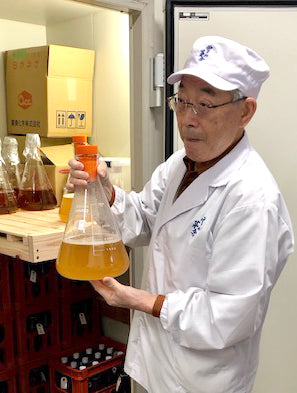 Sake Gumi is our monthly sake subscription service with 200 members throughout California. Join today!
Sake Gumi is our monthly sake subscription service with 200 members throughout California. Join today!
Yeast is one of the four main ingredients of sake, the others being rice, water, and koji. Yeast is very important in sake-making because as the koji is converting rice starches into glucose, the yeast converts the glucose into alcohol. In the process, yeast produces carbon dioxide, amino acids, and esters. Brewers choose different types of yeasts for their stamina, ability to work at different temperatures, and aroma.
As explored in December 2019 with the theme Yeast #9, we learned that most sakes are made using yeast obtained from the Nihon Jozo Kyoukai (Brewing Society of Japan). The yeasts that have been isolated and cultivated by this society are numbered 6-18. Number 7 and 9 are the most commonly used yeasts, typically used for junmai, and ginjos respectively.
Why do brewers go through the trouble of using their proprietary yeasts? Mr. Takahashi and his team at Saiya Brewery gave this reason, “In the past, the Japanese sake market was required to produce a lot of cheap sake on the premise of mass production and consumption. After that, as the beer and wine markets expanded, and the consumption of sake decreased, the sake industry entered a difficult era. To survive, we decided to make high quality sake that went beyond the old era of sake-making. In addition to using natural methods, like muroka and genshu, we decided to brew sake using our own cultured yeasts.”

Mr. Takahashi of Saiya Brewery holds the brewery’s 30 year old yeast
The Kinoshita brothers of Amabuki Brewery also started using unusual flower yeasts to stand out from the rest. Mr. Hosokawa from Amabuki explained, “We used yeast from the abelia flower for our daiginjo because the yeast profile makes it distinct from other daiginjos. 20 years ago, sake made with flower yeasts were not taken seriously, so we wanted to prove their potential by making high quality sake with it.”
When tasting for yeast, I recommend tasting the sakes in bulbous glassware like a bordeaux wine glass. This allows you to take in the complexities of the aromas from the yeast. Because yeast is so much about engaging your olfactory senses, I take a few moments of breathing the sake in before taking a sip.

G74 yeast, used for Shirataki Brewery’s Uonuma Noujun Junmai
From intense aromatics to higher acidity levels, you can tell these sakes aren't using the same old Yeasts #7 and #9!
Yoko
Co-Founder + Sake Director, Umami Mart
LEVEL 1: Introductory Membership (Two 300ml bottles)
 Yuki no Bosha Junmai Ginjo
Yuki no Bosha Junmai Ginjo
Saiya Brewery (Akita, Japan)
Seimaibuai: Akita Sake Komachi 55%, SMV: +1.5
Yeast: House
As toji Mr. Takahashi gains more experience, he says he takes an increasingly hands off approach. In addition to creating sakes that are muroka genshus, he also uses a house yeast that has been kept at the brewery for over 30 years. This yeast is robust, and he discovered that he did not need to stir the moromi (main mash) as much and had reduced stirring over the years, until he completely stopped in mid-90s. He keeps his mash at a low temperature, and lets the yeast work at the bottom of tank. We like the soft peach and strawberry flavors accented with a little bit of spice and umami. Try this clean sake chilled with vinegar-dressed salads, grilled mackerel or sardines.
 Senkin "Immortal Wing" Modern Kame no O Junmai Daiginjo
Senkin "Immortal Wing" Modern Kame no O Junmai Daiginjo
Senkin Brewery (Tochigi, Japan)
Seimaibuai: Kame no O 50%, SMV: -2
Yeast: Tochigi
Similar to Mr. Takahashi, Mr. Usui of Senkin Brewery lives by the motto, “Yokei na koto shinai” (do nothing unnecesarry). His sakes are muroka genshus that are pasteurized only once. Senkin created a line of sakes called Modern with higher acidity and residual sugar levels for bright and refreshing sakes. Applying the same concept as a Domaine or Estate, Senkin uses the same water for brewing that is used for growing the rice that was harvested just five minutes from the brewery. Try chilled with or at room temperature with grilled chicken dabbed with yuzu kosho, or smoked salmon with slices of lemon.
LEVEL 2: Premium Membership (Two 720ml bottles)
 Amabuki Daiginjo
Amabuki Daiginjo
Amabuki Brewery (Saga, Japan)
Seimaibuai: Yamada Nishiki 40%, SMV: +5
Yeast: Abelia Flower
Nearly 20 years ago, Amabuki differentiated itself from other breweries by specializing in using flower yeasts. From rhododendron and sunflowers to abelia flowers, they go out of their way to use these delicate and finnicky yeasts to bring out new aromatics in sake. The Kinoshita brothers, who own the brewery, studied under Professor Nakata at Tokyo University of Agriculture, who discovered various flowers yeasts. This gave them the idea to brew with flower yeasts. Abelia yeast yields raspberry and cherry aromas, a melon flavor with a sharp finish. Delicious chilled with beets or proscuitto.
 Uonuma Noujun Junmai
Uonuma Noujun Junmai
Shirataki Sake Brewery (Niigata, Japan)
Seimaibuai: Yamada Nishiki + Mizuhonokagayaki 80%, SMV: +2
Yeast: G74
G74 was discovered in Niigata in 1991, and has since been used in the fermentation of Santol wine making in Southeast Asia. Sake makers use this yeast for creatings bold sakes with high acidity that can be aged (this sake has been aged for two years). Uonuma Noujun is indeed bold, juicy, and savory, with an intoxicating aroma of buttered bread, vanilla, and plum jam. Have this Extreme Junmai (80% polishing ratio!) in a bulbous wine glass at room temperature with pasta sprinkled with grana padano.




Comments (0)
There are no comments for this article. Be the first one to leave a message!